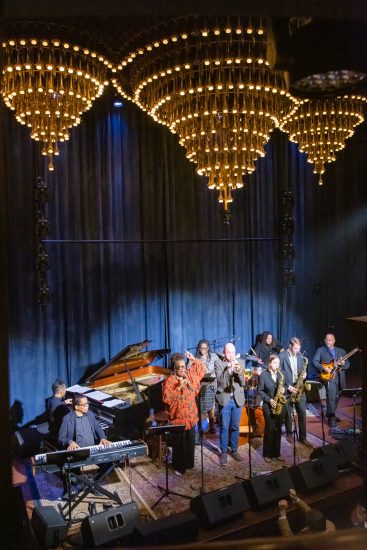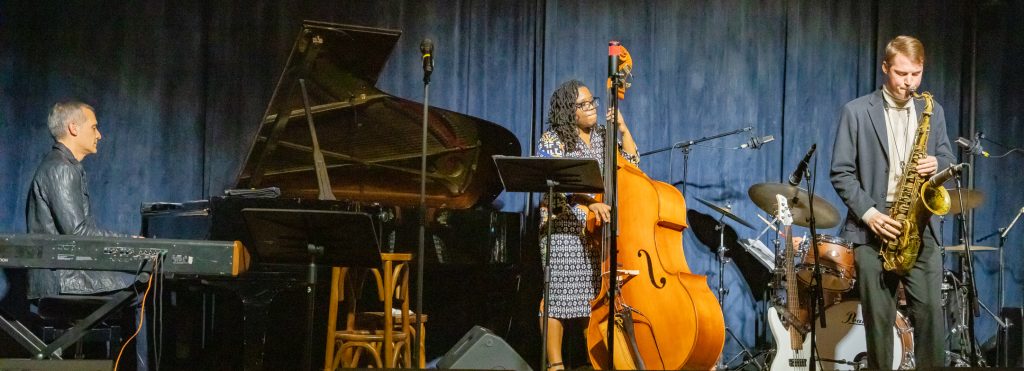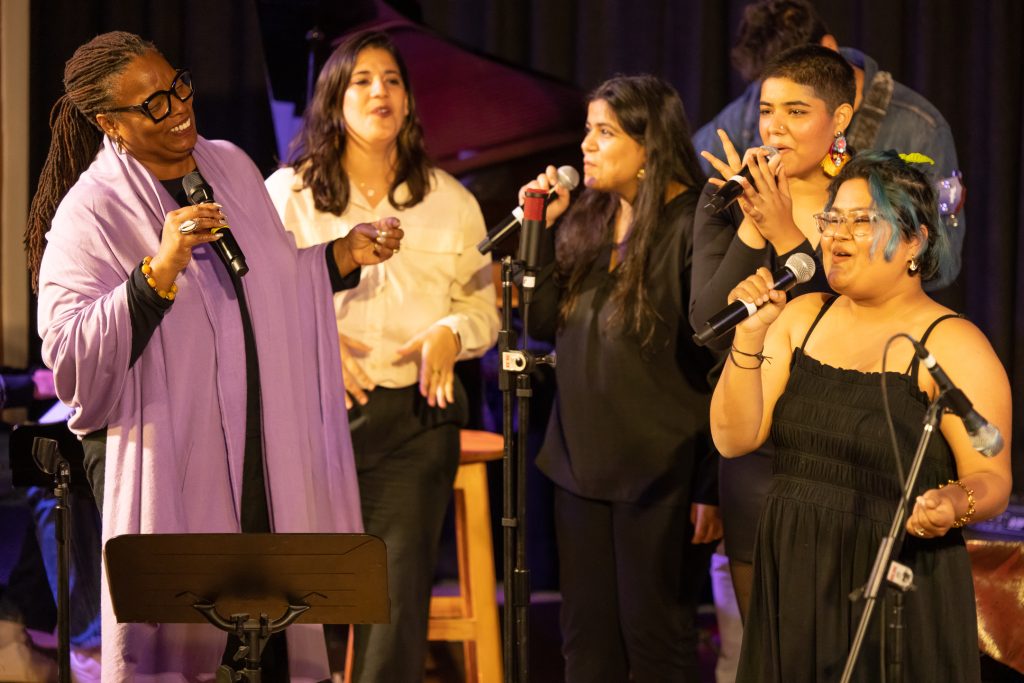DOWNLOAD THE PRESS RELEASE HERE.
Featuring Internationally Renowned Recording Artists TERELL STAFFORD and LISA HENRY
Weeklong series of events includes a free performance open to the public at Surbrugg/Prentice Auditorium at Laramie County Community College on May 16
Washington, DC – With lead funding from the National Endowment for the Arts and United Airlines, the Herbie Hancock Institute of Jazz will bring its Peer-to-Peer jazz education program to Albany and Laramie County public schools May 13-17, 2024. Combining performance with educational information, these “informances” will be presented by the Institute’s National Peer-to-Peer Jazz Quintet, comprising five of the country’s most gifted high school music students. They will be featured alongside internationally acclaimed trumpet recording artist Terell Stafford, Kansas City jazz and blues vocalist and a former winner of the Institute’s International Jazz Vocals Competition Lisa Henry, and renowned jazz educator Dr. JB Dyas. Each school visit will include an assembly program featuring a musical performance for all students, followed by workshops for each school’s jazz band and choir with the visiting student performers playing alongside and sharing ideas with their Wyoming counterparts.
“We’ve found that sometimes young people can learn about certain things better from kids their same age, and one of them is jazz,” said jazz great Herbie Hancock, Institute Chairman, NEA Jazz Master, and Goodwill Ambassador for the United Nations Educational, Scientific and Cultural Organization (UNESCO). “And when you hear how accomplished these musicians are at such a young age, you know their peers are going to listen.”
Besides playing jazz at a level that belies their years, the students will talk with their Wyoming peers about what jazz is, why it’s important to America, and how a jazz ensemble represents a perfect democracy. They also will discuss the important American values that jazz represents: teamwork, unity, the correlation of hard work and goal accomplishment, perseverance, and the importance of finding a passion early in life, being persistent, and believing in yourself. When young people hear this important message from kids their same age, they are often more likely to listen.
The members of the high school all-star quintet selected nationwide to participate in the Wyoming tour include saxophonist Quinn Rehkemper from Baltimore; vibraphonist Wanye Williams from Chicago; pianist Taylor Lee from Los Angeles; bassist Mia Desalos from Houston; and drummer Enzo Pulley from Miami. “I had the opportunity to perform with Mr. Stafford last year at the U.S. Department of Education in Washington, DC, where we presented a jazz informance with Secretary of Education Dr. Miguel Cardona to highlight the importance of music education in our public schools,” said Rehkemper. “And now actually getting to tour with Mr. Stafford is a dream come true.”
Immediately following the informances, Stafford, Henry, and Dyas will conduct jazz workshops for each host school’s jazz band and choir. The visiting students will play side-by-side with their Wyoming counterparts, providing tutelage peer to peer. In so doing, they will teach and learn from one another not unlike what Herbie Hancock did with Miles Davis, Wayne Shorter, and so many other eminent jazz artists for over half a century. They’ll also learn about each other’s cities and cultures.
“I’m really looking forward to going to Wyoming,” added Taylor Lee, the student from Los Angeles. “Wide open spaces, clean air, no traffic – I might just stay!”
The weeklong tour will include a free concert open to the public on May 16 at 7:00 pm at Laramie County Community College’s Surbrugg/Prentice Auditorium (1400 E College Dr) where Cheyenne residents and visitors are invited to enjoy an evening of music with Stafford and Henry alongside jazz’s future “young lions.” The septet will perform standards, jazz classics and contemporary jazz, including tunes from Stafford’s and Henry’s latest recordings. For further information, call 307-778-1120.
About The Artists & Educators
Terell Stafford is one of the top jazz trumpeters on the scene today. Born in Miami and raised in Chicago and Silver Spring, Maryland, Stafford attended the University of Maryland and Rutgers University, where he earned his bachelor’s and master’s degrees, respectively. While at Rutgers, he was invited to join Bobby Watson’s group, Horizon, with whom he performed and recorded for five years. He has since gone on to appear on more than 140 albums and perform around the globe with such eminent jazz artists as Kenny Barron, Benny Golson, Antonio Hart, Jimmy Heath, Diana Krall, Branford Marsalis, Mulgrew Miller, Billy Taylor, McCoy Tyner, Cedar Walton, Tim Warfield, and Frank Wess. Stafford is currently a member of the iconic Grammy Award-winning Vanguard Jazz Orchestra and the Grammy-nominated Clayton Brothers Quintet, in addition to his own quintet. He has recorded ten albums as leader, including his critically acclaimed latest release, Between Two Worlds (Le Coq Records, 2023). He also serves as artistic director of the Jazz Orchestra of Philadelphia. Besides being an internationally acclaimed performer and prolific composer, Stafford is a renowned educator and enjoys working with up-and-coming young jazz artists. He currently serves as director of jazz studies and chair of instrumental studies at Temple University in Philadelphia. www.terellstafford.com
Lisa Henry is a dynamic vocalist with a combination of swingin’ cool and down home class. A Kansas City native, she began by singing gospel music in the Baptist church, and by age 12 was singing the music of Billie Holiday and Miles Davis. Henry was a winner of the Herbie Hancock Institute’s International Jazz Vocals Competition and was later named an International Jazz Ambassador to Africa. She toured Chile, Argentina, and Peru with the Institute in the 1990s, performing for 34 Heads of State at the Summit of the Americas. In 2006 she participated in a U.S. State Department-sponsored tour of India and performed for an esteemed presidential dinner at the White House, celebrating the Institute’s 20th Anniversary. Over the past 25 years, Henry has toured the globe, sharing the stage with such artists as Ambrose Akinmusire, Kenny Barron, Don Braden, Bobby Broom, Gerald Clayton, Robin Eubanks, Kenny Garrett, Herbie Hancock, Roy Hargrove, Antonio Hart, Ingrid Jensen, Sean Jones, Kevin Mahogany, Delfeayo Marsalis, Wayne Shorter, Terell Stafford, Bobby Watson and Steve Wilson. Her Live from 18th and Vine recording has been lauded by jazz fans and critics alike. www.lisahenryjazz.com
Dr. JB Dyas has been a leader in jazz education for the past two decades. Formerly the Executive Director of the Brubeck Institute, Dyas currently serves as Vice President for Education and Curriculum Development at the Herbie Hancock Institute of Jazz. He oversees the Institute’s education and outreach programs including Jazz In America: The National Jazz Curriculum (www.jazzinamerica.org), one of the most significant and wide-reaching jazz education programs in the world. Throughout his career, he has performed across the country, taught students at every level, directed large and small ensembles, and developed and implemented new jazz curricula. He has written for DownBeat magazine and other national music publications, presented numerous jazz workshops, teacher-training seminars and jazz “informances” around the globe with such renowned artists as Dave Brubeck and Herbie Hancock, and created a series of teacher-training jazz education videos. Dr. Dyas received his master’s degree in Jazz Pedagogy from the University of Miami and PhD in Music Education from Indiana University, and is a recipient of the DownBeat Achievement Award for Jazz Education.
About the Herbie Hancock Institute of Jazz
The Herbie Hancock Institute of Jazz is a nonprofit education organization with a mission to offer the world’s most promising young musicians college level training by internationally acclaimed jazz masters and to present public school music education programs for young people around the world. The Institute preserves, perpetuates and expands jazz as a global art form, and utilizes jazz as a means to unite people of all ages, backgrounds and nationalities. All of the Institute’s programs are provided free of charge to students, schools and communities worldwide. The Institute’s programs use jazz as the medium to encourage imaginative thinking, creativity, a positive self-image, and respect for one’s own and others’ cultural heritage. Jazz great Herbie Hancock serves as the Institute’s Chairman. www.hancockinstitute.org.
About the National Performing Arts High School Jazz Program
The Herbie Hancock Institute’s National Performing Arts High School Jazz Program facilitates the education of gifted music students who attend public performing arts high schools across the nation. The Program offers them opportunities to participate in pre-conservatory, highly specialized, performance-based jazz curricula; study with some of the world’s most eminent jazz artists and educators; perform in jazz ensembles comprising their peers; and prepare for entry into the country’s most distinguished conservatories and university schools of music. Included is instruction in Jazz Improvisation, Theory, Composition, History, and Styles and Analysis. The Institute works with each school in developing jazz curricula and instructional methodology; provides ongoing private and group instruction with Institute teaching staff, visiting artists and educators; offers special residences with jazz masters; arranges high-profile performance opportunities for the student ensembles; and assists graduating seniors with securing college scholarships.
About the Peer-to-Peer Jazz Education Initiative
Through the Herbie Hancock Institute’s National Peer-to-Peer Jazz Education Initiative, which receives lead funding from the National Endowment for the Arts and United Airlines, outstanding music students from public performing arts high schools across the nation are invited to participate in weeklong peer-to-peer jazz informance tours. The young musicians gain invaluable performance experience playing alongside internationally acclaimed artists while they, in turn, help educate young audiences in public schools throughout the U.S. about jazz, America’s indigenous musical art form. In so doing, they not only help develop jazz audiences for the future, but also exemplify the deeply held American values that jazz represents: teamwork, unity, democracy, persistence and perseverance, and the vital importance of really listening to one another.
* Media Day/VIP Concerts
- Laramie – Tuesday, May 14 • 11:55 am – Laramie High School, 1710 Boulder Dr, Laramie, WY 82070
With special guests Mayor Patrick Harrington, City of Laramie; Vice Mayor Sharon Cumbie, City of Laramie; Superintendent John Goldhardt, Albany County School District
- Cheyenne – Friday, May 17 • 10:15 am – East High School, 2800 E Pershing Blvd, Cheyenne, WY 82001
With special guests Governor Mark Gordon, State of Wyoming; Mayor Patrick Collins, City of Cheyenne; Chief of Staff Dicky Shanor, Wyoming Department of Education; Cheyenne Field Representative Karmen Rossi, Office of U.S. Senator Cynthia Lummis; Superintendent Stephen Newton, Laramie County School District
For more information, full-length bios and photos, or to schedule an interview with the artists and/or students, please contact: JB Dyas at jbdyas@hancockinstitute.org or 323-270-3904.





